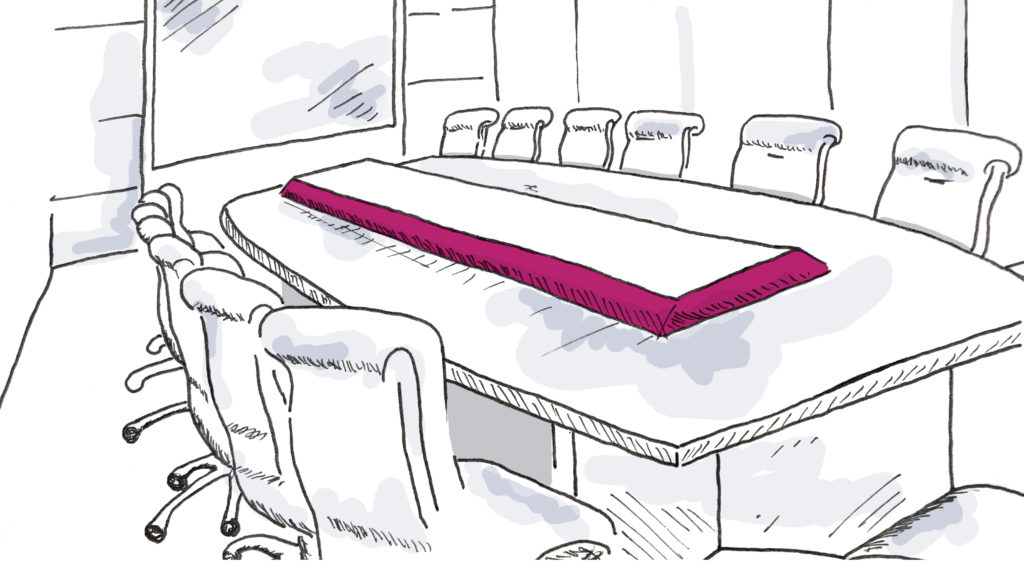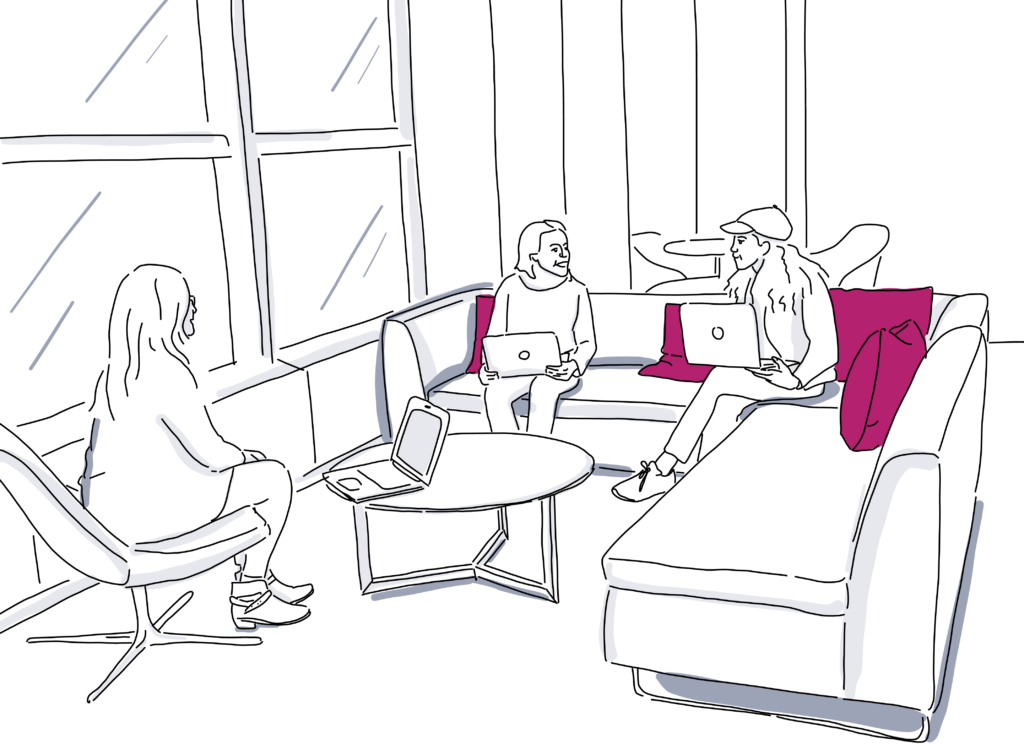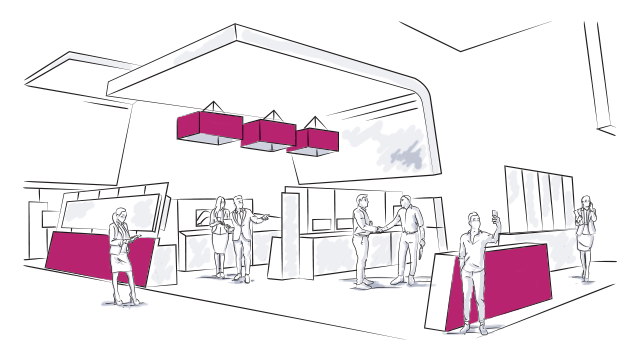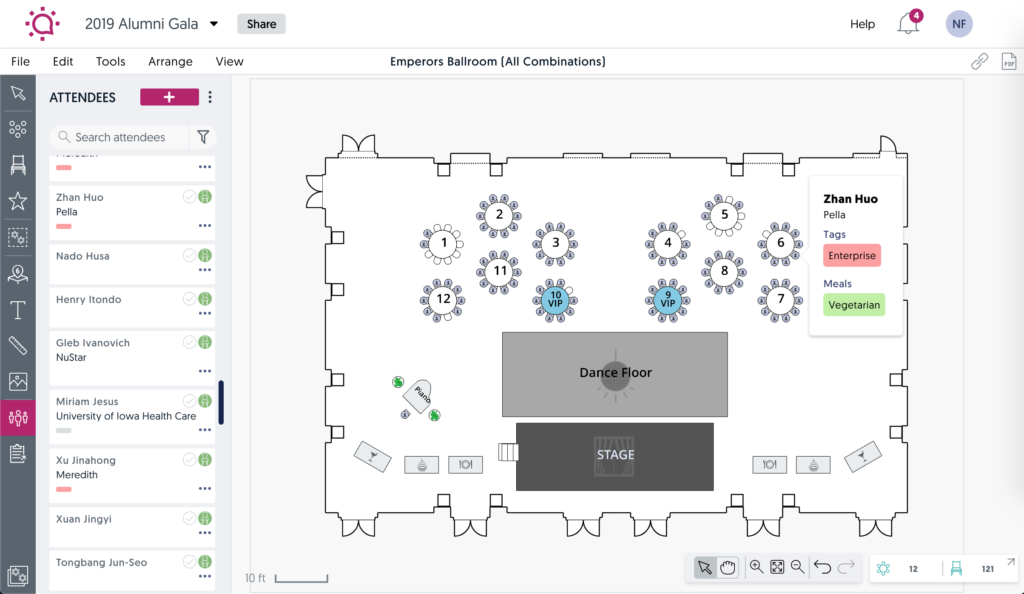
Must-Know Event Floor Plan Best Practices
When an event floor plan is designed well, guests don’t notice. Their focus is exactly where it should be”on enjoying the wedding celebration, university awards reception, or fundraising gala they’re attending.
But when event floor plans are designed poorly”it’s all guests notice. Attendees are cramped, uncomfortable, confused, or a bit lost. Guests may have trouble reaching their seats, get boxed in, or even feel exasperated because they can’t see the festivities or the guest speaker.
Read on to learn how to design outstanding event floor plans that make guests comfortable, put them at ease, and allow them to enjoy all the celebrating, learning, feasting, or networking on offer”from start to finish.
Discover 10 steps to making better event floor plans:

1. Don’t miss critical measurements
Knowing the size and layout of the event space is essential. Venue managers have the jump on this since they are on-site, and many event planners have go-to locations they know like the backs of their hands.
But for planners exploring new venues, designing corporate events across the country, or creating destination weddings, the process is trickier.
Here are options to get the lay of the land fast:
- Planners with event diagramming and collaboration software can reach out to the venue and ask them to share digital event space layouts if they have them.
- Planners without specialized software should still ask for a digital map of the layout with square footage included. (Store this information to streamline planning for future events.)
- Some brand new venues may not have details at the ready. In these instances, planners can request the measurement and layout details, or visit the site with a mechanical measuring wheel and notebook in-hand.
2. Jumpstart layout planning with an accurate headcount
Next up: Determine the number of people attending the event. Lock this down as early as possible in the planning process to avoid serious snafus, such as guests outnumbering venue capacity.
Attendee numbers also help clarify optimal layout options. For a wedding that’s approaching capacity, round tables optimize space and fit the most guests. A corporate event with a light turnout projection benefits from a floor plan design that draws guests together and facilitates networking.
Pro-tip for event planners: Establish the importance of a final headcount at the project kick-off meeting with planning team members and clients.

[Tweet “When an event floor plan is designed well, guests don’t notice. Their focus is exactly where it should be.”]
3. Get event sightlines right with creative setups
Nobody wants to show up to a panel discussion or a ceremony only to find they can’t see the action. Rows upon rows of seats, one immediately behind the other at the same level, is a recipe for frustrated attendees.
Consider these tips and floor plan layout options for unobstructed views:
- Panel discussions and lectures benefit from a room layout that includes a dais or stage, or stadium seating.
- Stagger seats so guests look between the shoulders of the people directly in front of them rather than at the back of their heads.
- In-the-round or U-shaped seating with the ceremony, speaker, or demonstration situated in the middle is an excellent option for smaller events.
- Put space between attendees and the speaker or newlyweds. More people can see when there’s a small buffer of empty space between the happy couple or panel guests and the audience.
- It should go without saying, but video screens and whiteboards should be large and set high enough so the people in the back can see as clearly as those up front.
Check out our meeting room layout guide for examples of table, chair, and stage arrangements:
4. Customize event A/V for superb sound
Audio equipment layouts are an essential element of event floor plans, particularly at larger venues. The best audio setups are unobtrusive and customized for the specifics of the event layout, such as low ceilings that impact the acoustics, or overflow wings or rooms that require dedicated speakers.
Importantly, audio equipment and cables must be situated so they don’t create trip hazards.
Additionally, pay attention to the location and mic setup of live musicians and singers. At large-scale events, musicians situated away from the action may barely register with your guests, while bands with amplifiers set too loud can become the focus of the event when they should be the supporting act.
Pro-tip: Take a cue from the theater and do a sound check before the event to make sure everyone can hear, but it’s not too loud.
5. Make guests comfortable with more moving room
More is usually better when it comes to space between tables and chairs at an event. Guests should feel they can push out their chairs and stand up without inconveniencing neighbors or bumping people behind them.
In theater-type seating layouts, guests in the middle should have room enough to get to the aisle without practically sitting in strangers’ laps or knocking into the backs and shoulders of the people in the row in front of them.
Create wider aisles for easy room navigation by caterers, the Master of Ceremonies, performers, and special guests.
6. Plan out high-traffic routes
People mill around at events. Attendees finding their seats, speakers getting to the podium, award recipients reaching the stage, people searching for the restrooms”guests are constantly in motion.
Create routes for every activity through the event and clarify the best routes with directions from event staff, helpful signage, and intuitive room layouts.
Layout tips for smooth guest movements during events:
- Place extra space between tables near exit doors.
- Establish a clear route between honored guests, speakers, or award recipients and the microphone or stage.
- Give instructions to special guests so they understand where they need to go and the best route.
- Leave space around the dance floor.

7. Focus on accessibility issues to ensure ADA compliance
Accessible event floor plans are a legal and ethical imperative for event planners. Accessibility issues in event floor planning include:
- Ramps for guests in wheelchairs
- Space at tables for guests in wheelchairs or with medical support equipment
- Podium for American Sign Language translators
- Accessible exits
- Wide aisles for people with wheelchairs, canes, and medical support equipment
- Wheelchair lifts and elevators to stage
Pro-tip: Certain historical/older locations are not required to meet all ADA standards. It’s important to communicate with clients about the limitations of the venue for people with disabilities.
8. Keep fire and safety precautions on the radar
Event floor plans must prioritize guest and employee safety at all times, and venues should meet local codes and have safety protocols in place.
Discuss safety measures with venue managers, and develop a sharp eye for problems, such as locked or blocked exit doors, poor lighting, and trip hazards.
9. Streamline layouts with event floor plan software
With an event floor plan maker, much of the above becomes fast work. Event diagramming and floor plan software enable venues and planners to map event layouts quickly while adjusting for sightlines, crowd flow, and comfort.
Event designers can use the floor plan software to build customized layouts from scratch, tailor existing templates, and upload existing arrangements offered by tech-savvy venues. Social Tables’ floor plan maker enables 3D mockups of event layouts for virtual walkthroughs and early troubleshooting.

10. Do a final walkthrough before the event
Even if you use floor plan design software, a real-world walkthrough of the venue is necessary when all of the tables, chairs, booths, and event equipment are in their places. An in-person walkthrough is the best way to determine if anything is off kilter”which is inevitable even with the most detailed layout designs.
It’s a lot to manage, track, and triple-check, but floor plans can make or break an event. Integrate the above best practices into every new project to create floor plans that wow clients and support the goal of the event.
Ready to learn more about creating event floor plans?
Find out which event room sets are most popular with Social Tables planners, and the 5 reasons floor plans are the foundation of your event. Then, discover six ways to get creative with event rendering software.

